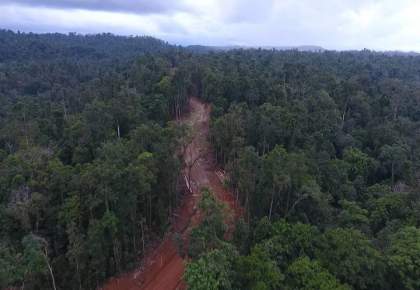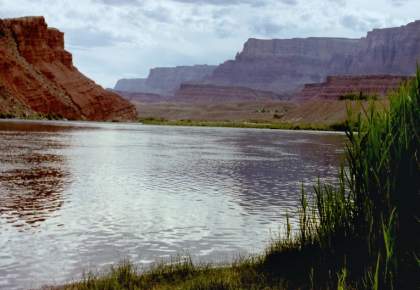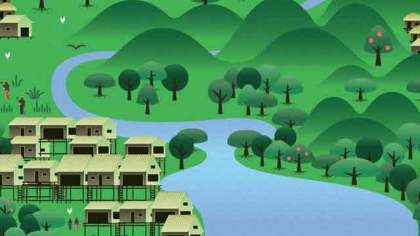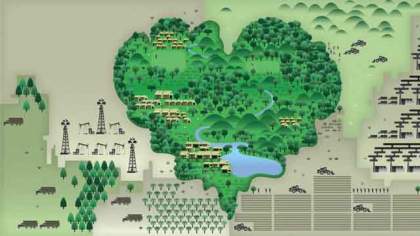-
What is 'Land Rights' about?
This video describes and compares community concessions on state land, individual land ownership and communal ownership of territory. The video is especially for communities whose land rights have not yet been recognised, to help them think through what type of rights they want.
Length of Video
14 minutes.
Why Screen 'Land Rights'?
This video, based on experiences from Latin America, Africa and Indonesia, discusses community concessions on state land, and individual certification, both approaches that many governments and international institutions are promoting. It compares these with the recognition of communal rights over territory, which indigenous peoples around the world feel best reflect their cultural and spiritual connections to their lands, resources and territories.
Where are the communities in this video from?
Merangin, Molo, Pandumaan-Sipituhuta, Penunggu - Indonesia
Secoya – Ecuador
Maasai – TanzaniaDownload 'Land Rights' here.
Watch in French, Spanish, Indonesian and Swahili
Suggestions for Discussion Questions after community screenings
- In what way do you expect the State to recognize indigenous peoples?
- What rights do you seek over your lands and natural resources?
- If you seek self-governance, through which institutions will you govern yourselves? How will you relate to the local government?
- What are the boundaries of your territory, what does your territory include and exclude?
- Who now owns the land that makes up your ancestral territory? How has this situation changed over the past decades?
- What is the role of customary institutions and leadership in managing your territory?
- What are your rules about selling land and splitting up the territory?
- What are the advantages and disadvantages of individual land rights?
- What are the advantages and disadvantages of concession rights?
- What are the advantages and disadvantages communal land rights?
Suggestions for Follow-up Activities after community screenings
- Find out about the policies and current situation of land rights for indigenous peoples in your country.
- Do a role-play in which your community has no rights to your territory. Separate into three groups and have each group argue for the benefits or the drawbacks of individual rights, community concessions and communal rights.
-
Documents and Downloads
Indigenous peoples’ rights to lands, territories, and resources
The new study by ILC confirms what we knew: indigenous peoples entertain special relationships with their lands, territories and resources, as these are central to their world view, their cultures, livelihoods, spirituality, identity, and their continued existence as distinct peoples. The author of the present study, Birgitte Feiring, is a renowned anthropologist who has worked on indigenous peoples’ rights and development for more than 25 years in several agencies worldwide, including as the ILO Chief Technical Adviser on Convention No. 169 and as an adviser to bilateral and multilateral agencies and to indigenous peoples themselves. (International Land Coalition, 2013)
Whose Land Is It? Commons and Conflict States
This paper addresses the tenure fate of three commons: the 30 million hectares of pasturelands of Afghanistan which represent 45 percent of the total land area and are key to livelihood and water catchment in that exceedingly dry country; the 5.7 million hectares of timber-rich tropical forests in Liberia, 59 percent of the total land area; and the 125 million hectares of savannah in Sudan, half the area of that largest state of Africa. All three resources have an uncountably long history as customary properties of local communities. They also share a 20th century history as the property of the state. Of course there is nothing unusual in this contradiction. Between one and two billion people on the planet today are tenants of the State (CLEP, 2008, Alden Wily, forthcoming (b)). They live on and use traditional properties on which, in the eyes of the national laws of those countries, they are no more than lawful occupants and users. When their expansive collectively-owned forest, pastoral and swamp lands are taken into account, up to five billion hectares are involved, potentially one third of the world’s total land area (Wily / RRI, 2010).
Who Owns The Land in Africa? Formal recognition of community-based land rights in Sub-Saharan Africa
This brief summarizes findings on community ownership and control of lands in 19 countries in Sub-Saharan Africa that were included in the RRI's global baseline study (RRI, 2015).
Rights to Resources in Crisis: Reviewing the Fate of Customary Tenure in Africa
This is the first in a series of briefs about modern African land tenure that provides up-to-date analysis on the status of customary land rights in Sub-Saharan Africa. The purpose of the series is to inform and help to structure advocacy and action aimed at challenging the weak legal status of customary land rights in many African countries (Wily / RRI, 2012).
Securing community land and resource rights in Africa: A guide to legal reform and best practices
This guide, produced by FERN, the Forest Peoples Programme (FPP), ClientEarth and the Centre for Environment and Development (CED), explains key aspects of law and land rights that are important for securing community ownership and control of land and resources – also referred to as secure land and resource tenure. It explains how to identify and create opportunities for law reform and offers examples of reforms that have taken place in several African countries (2014).
Land rights and the forest peoples of Africa: Historical, legal and anthropological perspectives
FPP has published a series of five country studies, and an in-depth overview, examining indigenous peoples' land rights in the forested countries of Africa. The country studies have been produced in collaboration with African experts from Burundi, Cameroon, Democratic Republic of Congo, Rwanda and Uganda (Forest Peoples Programme, 2009).
Land Rights Issues in International Human Rights Law
Up to one quarter of the world’s population is estimated to be landless, including 200 million people living in rural areas. For many of these people, the condition of landlessness threatens the enjoyment of a number of fundamental human rights. Access to land is important for development and poverty reduction, but also often necessary for access to numerous economic, social and cultural rights, and as a gateway for many civil and political rights. However, there is no right to land codified in international human rights law. This article, which was originally written as a briefing paper for the “Forum on Land, Business, and Human Rights” convened in Manesar, India by the Institute for Human Rights and Business in June 2009, provides a brief overview of the legal implications of access to land for a broad range of human rights. Land is a cross-cutting issue, and is not simply a resource for one human right in the international legal framework. Rights have been established in the international legal framework that explicitly relate to land access for particular groups, such as indigenous people and, to a more limited extent, women. In addition, numerous rights are affected by access to land, including the rights to housing, food, water and work, and general principles in international law also provide protections relating to access to land, such as equality and nondiscrimination in ownership and inheritance (Wickeri, Elisabeth and Kalhan, Anil, Land Rights Issues in International Human Rights Law. Malaysian Journal on Human Rights, Vol. 4, No. 10, 2010; Drexel University Earle Mack School of Law Research Paper ; Fordham Law Legal Studies Research Paper No. 1921447).
What Rights? A Comparative Analysis
'What Rights? A Comparative Analysis of Developing Countries’ National Legislation on Community and Indigenous Peoples’ Forest Tenure Rights' presents a legal analysis of the national legislation that relates to Indigenous Peoples’ and communities’ forest tenure rights at a global scale by assessing whether the legal systems of 27 of the most forested developing countries of the world recognize the rights of Indigenous Peoples and communities to access, withdraw, manage, exclude and alienate to forest resources and land. The countries included in this study are home to 2.2 billion rural people and include approximately 75% of the forests in the developing world (RRI, 2012).
Legally Securing Community Lands: Principles & Paths
Land tenure specialist Liz Alden Wily's principles and paths for securing tenure of community lands (2013).
Other videos
Our Land, Our Life
"Our Land, Our Life" presents the struggle of Carrie and Mary Dann, two Western Shoshone elders, to address the threat mining development poses to the sacred and environmentally sensitive lands of Crescent Valley, Nevada (Oxfam America, 2008).
Related links
Rights and Resources Initiative (RRI) Eng
The RRI coalition are directly engaged in land and forest policy reforms in close to 20 countries throughout Africa, Asia and Latin America. Together, they are working to encourage greater global commitment and action on pro-poor tenure, policy and market reforms.
Tebtebba
Working for the respect, protection and fulfillment of indigenous peoples’ rights and operationalization of indigenous peoples’ self-determined sustainable development
El Buen Vivir and The Commons: A Conversation Between Gustavo Soto Santiesteban and Silke Helfrich
A conversation between Gustavo Soto Santiesteban, a Bolivian researcher and consultant on indigenous issues and Silke Helfrich, an author and commons activist, about the indigenous notion of buen vivir and the commons. Featured in The Wealth of the Commons: A World Beyond Market and State.
-
Land Rights News

Farmers walk from N. Sumatra to Jakarta to demand Jokowi settle land dispute
Hundreds of farmers have walked thousands of kilometers from their homes in Deli Serdang regency, North Sumatra, to the capital city. SOURCE: Nina A. Loasana The Jakarta Post

PNG villagers count huge cost of damage from logging
Communities in Papua New Guinea's West Pomio District will suffer more than $US 730 million worth of damage due to Special Agriculture Business Leases, according to a local advocacy group. (By RadioNZ)

Environmental lawyers seek legal rights for the natural world
Rivers and other natural features have intrinsic rights and should own themselves, rather than being considered property (Source PRI)

Rights of indigenous peoples in Peru make a step forward
After months of struggle, the government in Peru has committed to respecting the rights of indigenous communities affected by oil exploitation. (Source Oxfam Peru)

Tanzania ends hunting deal near Loliondo with UAE royal family; compromised government officials
Tanzania ends hunting deal with Dubai royal family (Source: Africa Sustainable Conservation News)

First global pact backing indigenous land rights launched
The International Land and Forest Tenure Facility dedicated to securing the land rights of indigenous communities worldwide has been formally launched. (The Straits Times)

Six farmers shot dead over land rights battle in Peru
The victims were targeted by a criminal gang who wanted to use their lands to grow lucrative palm oil, according to local indigenous leaders (Collyns / The Guardian)

‘We’d rather die than lose’: villagers in Indonesia fight for a land rights revolution
A small community on the island of Sumatra is at the heart of a battle for traditional territories that could finally resolve the muddled and exploitative system of laws governing land ownership in Indonesia. (Bevins / the Guardian)

Illegal logging and hunting threaten Yasuní isolated indigenous groups
Yasuní National Park and the Tagaeri-Taromenane Intangible Zone (ZITT), home to isolated indigenous groups, have become hotspots of illegal logging and hunting. (Source: Mongabay)

Rivers Get Human Rights: They Can Sue to Protect ThemselvesIn New Zealand and Ecuador, rivers with l
In New Zealand and Ecuador, rivers with legal aspects of “personhood” open up new environmental battles (By Mihnea Tanasescu - Scientific American)

Huge victory for Kenya’s Ogiek
African Court sets major precedent for indigenous peoples’ land rights (FPP / Minority Rights Group International)

Amazonians call on leaders to heed link between land rights and climate change
As Paris climate agreement comes into force, inhabitants of Amazon rainforest demand recognition of key role their communities play in conservation (Collyns / The Guardian)
LifeMosaic-CINEP workshop with Wiwa youth in Colombia
LifeMosaic and CINEP teamed up to bring our Territories of Life toolkit and workshops to youth from three Wiwa communities in the Sierra Nevada de Santa Marta.

The Community Land Act: Now it’s up to communities
At last Kenya has a Community Land Act. (By LIZ ALDEN WILY)

Mundemba declaration and statement of solidarity: women, communities say NO to oil palm expansion
A statement of solidarity with the communities of Ndian Division, Southwest Region of Cameroon acknowledging their courage whilst faced with the threat to their land rights from corporate oil palm plantations. (SEFE, RADD, CED, GRAIN and WRM / grain.org)

The indigenous community whose forest is their supermarket
Dayak Iban people who live along the Utik River in Indonesian Borneo have a special relationship with the surrounding environment (Andi Fachrizal / Mongabay).

Land rights: “Our territory belongs to us and we belong to our territory”
LifeMosaic’s new video on “Land Rights” takes a look at three different types of land rights: community concessions on state land, individual land ownership and communal ownership of territory. It’s the fourth in LifeMosaic’s series “Territories of Life“ (Chris Lang / redd-monitor.org).
Land Rights - Territories of Life
This video describes and compares community concessions on state land, individual land ownership and communal ownership of territory.

















